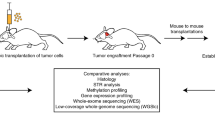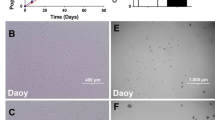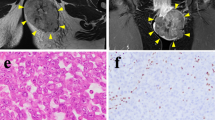Abstract
The paucity of cell culture models for childhood brain tumors prompted us to establish pediatric cell lines for use in biological experiments and preclinical developmental therapeutic studies. Three cell lines were established, CHLA-200 (GBM), CHLA-259 (anaplastic medulloblastoma) and CHLA-266 (atypical teratoid rhabdoid tumor, AT/RT). Consistent with an AT/RT origin, CHLA-266 lacked INI1 expression and had monosomy 22. All lines had unique DNA short tandem repeat “fingerprints” matching that of the patient’s tumor tissue and were adherent on tissue culture plastic, but differed in morphology and doubling times. CHLA-200 had a silent mutation in TP53. CHLA-259 and CHLA-266 had wild-type TP53. All three lines were relatively resistant to multiple drugs when compared to the DAOY medulloblastoma cell line, using the DIMSCAN fluorescence digital image microscopy cytotoxicity assay. RNA expression of MYC and MYCN were quantified using RT-PCR (Taqman). CHLA-200 expressed MYC, DAOY and CHLA-259 expressed MYCN, and CHLA-266 expressed both MYCN and MYC. CHLA-200 was only tumorigenic subcutaneously, but CHLA-259 and CHLA-266 were tumorigenic both subcutaneously and in brains of NOD/SCID mice. Immunohistochemistry of the xenografts revealed GFAP staining in CHLA-200 and PGP 9.5 staining in CHLA-259 and CHLA-266 tumors. As expected, INI1 expression was lacking in CHLA-266 (AT/RT). These three new cell lines will provide useful models for research of pediatric brain tumors.





Similar content being viewed by others
Abbreviations
- AT/RT:
-
Atypical teratoid/rhabdoid tumor
- VINC:
-
Vincristine
- 4-HC:
-
4-Hydroperoxycyclophosphamide
- L-PAM:
-
Melphalan
- CDDP:
-
Cisplatin
- 4-HPR:
-
Fenretinide
- TPT:
-
Topotecan
- ETOP:
-
Etoposide
- FBS:
-
Fetal bovine serum
- ITS:
-
Insulin, selenium, and transferrin
- GFAP:
-
Glial fibrillary acidic protein
- CNS:
-
Central Nervous System
References
CBTRUS (2005) Central Brain Tumor Registry of the US. 2005–2006 Statistical report: primary brain tumors in the United States, 1998–2002
Gurney JG, Smith MA, Bunin GR (1999) CNS and miscellaneous intracranial and intraspinal neoplasms. In: Ries LAG, Smith MA, Gurney JG, Linet M, Tamra T, Young JL, Bunin GR (eds) Cancer incidence and survival among children and adolescents: United States SEER program, 1975–1995. National Cancer Institute. SEER Program, NIH, Bethesda, pp 51–63
Bredel M (2001) Anticancer drug resistance in primary human brain tumors. Brain Res Brain Res Rev 35:161–204
Rorke LB, Packer RJ, Biegel JA (1996) Central nervous system atypical teratoid/rhabdoid tumors of infancy and childhood: definition of an entity. J Neurosurg 85:56–65
Reddy AT (2005) Atypical teratoid/rhabdoid tumors of the central nervous system. J Neurooncol 75:309–313
Robertson PL (2006) Advances in treatment of pediatric brain tumors. NeuroRx 3:276–291
DeAngelis LM (2005) Chemotherapy for brain tumors–a new beginning. N Engl J Med 352:1036–1038
Collins PJ, Hennessy LK, Leibelt CS, Roby RK, Reeder DJ, Foxall PA (2004) Developmental validation of a single-tube amplification of the 13 CODIS STR loci, D2S1338, D19S433, and amelogenin: the AmpFlSTR Identifiler PCR Amplification Kit. J Forensic Sci 49:1265–1277
Keshelava N, Zuo JJ, Chen P, Waidyaratne SN, Luna MC, Gomer CJ, Triche TJ, Reynolds CP (2001) Loss of p53 function confers high-level multidrug resistance in neuroblastoma cell lines. Cancer Res 61:6185–6193
Keshelava N, Frgala T, Krejsa J, Kalous O, Reynolds CP (2005) DIMSCAN: a microcomputer fluorescence-based cytotoxicity assay for preclinical testing of combination chemotherapy. Methods Mol Med 110:139–153
Frgala T, Kalous O, Proffitt RT, Reynolds CP (2007) A fluorescence microplate cytotoxicity assay with a 4-log dynamic range that identifies synergistic drug combinations. Mol Cancer Ther 6:886–897
Rutkowski S, Bode U, Deinlein F, Ottensmeier H, Warmuth-Metz M, Soerensen N, Graf N, Emser A, Pietsch T, Wolff JE, Kortmann RD, Kuehl J (2005) Treatment of early childhood medulloblastoma by postoperative chemotherapy alone. N Engl J Med 352:978–986
Villablanca JG, Krailo MD, Ames MM, Reid JM, Reaman GH, Reynolds CP (2006) Phase I trial of oral fenretinide in children with high-risk solid tumors: a report from the children’s oncology group (CCG 09709). J Clin Oncol 24:3423–3430
Yamada S, Khankaldyyan V, Bu X, Suzuki A, Gonzalez-Gomez I, Takahashi K, McComb JG, Laug WE (2004) A method to accurately inject tumor cells into the caudate/putamen nuclei of the mouse brain. Tokai J Exp Clin Med 29:167–173
Burgos JS, Rosol M, Moats RA, Khankaldyyan V, Kohn DB, Nelson MD Jr, Laug WE (2003) Time course of bioluminescent signal in orthotopic and heterotopic brain tumors in nude mice. Biotechniques 34:1184–1188
Otto-Duessel M, Khankaldyyan V, Gonzalez-Gomez I, Jensen MC, Laug WE, Rosol M (2006) In vivo testing of Renilla luciferase substrate analogs in an orthotopic murine model of human glioblastoma. Mol Imaging 5:57–64
Jacobsen PF, Jenkyn DJ, Papadimitriou JM (1985) Establishment of a human medulloblastoma cell line and its heterotransplantation into nude mice. J Neuropathol Exp Neurol 44:472–485
Puduvalli VK, Saito Y, Xu R, Kouraklis GP, Levin VA, Kyritsis AP (1999) Fenretinide activates caspases and induces apoptosis in gliomas. Clin Cancer Res 5:2230–2235
Damodar Reddy C, Guttapalli A, Adamson PC, Vemuri MC, O’Rourke D, Sutton LN, Phillips PC (2006) Anticancer effects of fenretinide in human medulloblastoma. Cancer Lett 231:262–269
Alarcon-Vargas D, Zhang Z, Agarwal B, Challagulla K, Mani S, Kalpana GV (2006) Targeting cyclin D1, a downstream effector of INI1/hSNF5, in rhabdoid tumors. Oncogene 25:722–734
Serra A, Gaidano GL, Revello D, Guerrasio A, Ballerini P, Dalla Favera R, Saglio G (1992) A new TaqI polymorphism in the p53 gene. Nucleic Acids Res 20:928
Raffel C, Thomas GA, Tishler DM, Lassoff S, Allen JC (1993) Absence of p53 mutations in childhood central nervous system primitive neuroectodermal tumors. Neurosurgery 33:301–305 Discussion 305–306
Grandori C, Cowley SM, James LP, Eisenman RN (2000) The Myc/Max/Mad network and the transcriptional control of cell behavior. Annu Rev Cell Dev Biol 16:653–699
Vasudevan SA, Nuchtern JG, Shohet JM (2005) Gene profiling of high risk neuroblastoma. World J Surg 29:317–324
Pfister S, Remke M, Benner A, Mendrzyk F, Toedt G, Felsberg J, Wittmann A, Devens F, Gerber NU, Joos S, Kulozik A, Reifenberger G, Rutkowski S, Wiestler OD, Radlwimmer B, Scheurlen W, Lichter P, Korshunov A (2009) Outcome prediction in pediatric medulloblastoma based on DNA copy-number aberrations of chromosomes 6q and 17q and the MYC and MYCN loci. J Clin Oncol 27:1627–1636
Swartling FJ, Grimmer MR, Hackett CS, Northcott PA, Fan QW, Goldenberg DD, Lau J, Masic S, Nguyen K, Yakovenko S, Zhe XN, Gilmer HC, Collins R, Nagaoka M, Phillips JJ, Jenkins RB, Tihan T, Vandenberg SR, James CD, Tanaka K, Taylor MD, Weiss WA, Chesler L (2010) Pleiotropic role for MYCN in medulloblastoma. Genes Dev 24:1059–1072
Ellison DW, Kocak M, Dalton J, Megahed H, Lusher ME, Ryan SL, Zhao W, Nicholson SL, Taylor RE, Bailey S, Clifford SC (2011) Definition of disease-risk stratification groups in childhood medulloblastoma using combined clinical, pathologic, and molecular variables. J Clin Oncol 29:1400–1407
Kim NW, Piatyszek MA, Prowse KR, Harley CB, West MD, Ho PL, Coviello GM, Wright WE, Weinrich SL, Shay JW (1994) Specific association of human telomerase activity with immortal cells and cancer. Science 266:2011–2015
Greider CW, Blackburn EH (1989) A telomeric sequence in the RNA of Tetrahymena telomerase required for telomere repeat synthesis. Nature 337:331–337
Nakamura TM, Morin GB, Chapman KB, Weinrich SL, Andrews WH, Lingner J, Harley CB, Cech TR (1997) Telomerase catalytic subunit homologs from fission yeast and human. Science 277:955–959
Rooprai HK, Merzak A, Bullock P, Pilkington GJ (1997) Establishment and characterization of two paediatric brain tumour cell lines in vitro. Anticancer Res 17:4127–4134
Di Tomaso E, Pang JC, Lam HK, Tian XX, Suen KW, Hui AB, Hjelm NM (2000) Establishment and characterization of a human cell line from paediatric cerebellar glioblastoma multiforme. Neuropathol Appl Neurobiol 26:22–30
Friedman HS, Burger PC, Bigner SH, Trojanowski JQ, Wikstrand CJ, Halperin EC, Bigner DD (1985) Establishment and characterization of the human medulloblastoma cell line and transplantable xenograft D283 Med. J Neuropathol Exp Neurol 44:592–605
Keles GE, Berger MS, Srinivasan J, Kolstoe DD, Bobola MS, Silber JR (1995) Establishment and characterization of four human medulloblastoma-derived cell lines. Oncol Res 7:493–503
Yachnis AT, Neubauer D, Muir D (1998) Characterization of a primary central nervous system atypical teratoid/rhabdoid tumor and derivative cell line: immunophenotype and neoplastic properties. J Neuropathol Exp Neurol 57:961–971
Packer RJ, Gajjar A, Vezina G, Rorke-Adams L, Burger PC, Robertson PL, Bayer L, LaFond D, Donahue BR, Marymont MH, Muraszko K, Langston J, Sposto R (2006) Phase III study of craniospinal radiation therapy followed by adjuvant chemotherapy for newly diagnosed average-risk medulloblastoma. J Clin Oncol 24:4202–4208
Chi SN, Zimmerman MA, Yao X, Cohen KJ, Burger P, Biegel JA, Rorke-Adams LB, Fisher MJ, Janss A, Mazewski C, Goldman S, Manley PE, Bowers DC, Bendel A, Rubin J, Turner CD, Marcus KJ, Goumnerova L, Ullrich NJ, Kieran MW (2009) Intensive multimodality treatment for children with newly diagnosed CNS atypical teratoid rhabdoid tumor. J Clin Oncol 27:385–389
Gardner SL, Asgharzadeh S, Green A, Horn B, McCowage G, Finlay J (2008) Intensive induction chemotherapy followed by high dose chemotherapy with autologous hematopoietic progenitor cell rescue in young children newly diagnosed with central nervous system atypical teratoid rhabdoid tumors. Pediatr Blood Cancer 51:235–240
Dhall G, Grodman H, Ji L, Sands S, Gardner S, Dunkel IJ, McCowage GB, Diez B, Allen JC, Gopalan A, Cornelius AS, Termuhlen A, Abromowitch M, Sposto R, Finlay JL (2008) Outcome of children less than three years old at diagnosis with non-metastatic medulloblastoma treated with chemotherapy on the “Head Start” I and II protocols. Pediatr Blood Cancer 50:1169–1175
Orellana C, Hernandez-Marti M, Martinez F, Castel V, Millan JM, Alvarez-Garijo JA, Prieto F, Badia L (1998) Pediatric brain tumors: loss of heterozygosity at 17p and TP53 gene mutations. Cancer Genet Cytogenet 102:93–99
Pollack IF, Finkelstein SD, Burnham J, Holmes EJ, Hamilton RL, Yates AJ, Finlay JL, Sposto R (2001) Age and TP53 mutation frequency in childhood malignant gliomas: results in a multi-institutional cohort. Cancer Res 61:7404–7407
Maltzman W, Czyzyk L (1984) UV irradiation stimulates levels of p53 cellular tumor antigen in nontransformed mouse cells. Mol Cell Biol 4:1689–1694
Fritsche M, Haessler C, Brandner G (1993) Induction of nuclear accumulation of the tumor-suppressor protein p53 by DNA-damaging agents. Oncogene 8:307–318
Kastan MB, Onyekwere O, Sidransky D, Vogelstein B, Craig RW (1991) Participation of p53 protein in the cellular response to DNA damage. Cancer Res 51:6304–6311
Cargioli TG, Ugur HC, Ramakrishna N, Chan J, Black PM, Carroll RS (2007) Establishment of an in vivo meningioma model with human telomerase reverse transcriptase. Neurosurgery 60:750–759 Discussion 759–760
Fan X, Wang Y, Kratz J, Brat DJ, Robitaille Y, Moghrabi A, Perlman EJ, Dang CV, Burger PC, Eberhart CG (2003) hTERT gene amplification and increased mRNA expression in central nervous system embryonal tumors. Am J Pathol 162:1763–1769
Herms J, Neidt I, Luscher B, Sommer A, Schurmann P, Schroder T, Bergmann M, Wilken B, Probst-Cousin S, Hernaiz-Driever P, Behnke J, Hanefeld F, Pietsch T, Kretzschmar HA (2000) C-MYC expression in medulloblastoma and its prognostic value. Int J Cancer 89:395–402
Eberhart CG, Kratz J, Wang Y, Summers K, Stearns D, Cohen K, Dang CV, Burger PC (2004) Histopathological and molecular prognostic markers in medulloblastoma: c-myc, N-myc, TrkC, and anaplasia. J Neuropathol Exp Neurol 63:441–449
Stearns D, Chaudhry A, Abel TW, Burger PC, Dang CV, Eberhart CG (2006) c-myc overexpression causes anaplasia in medulloblastoma. Cancer Res 66:673–681
Hayashi S, Yamamoto M, Ueno Y, Ikeda K, Ohshima K, Soma G, Fukushima T (2001) Expression of nuclear factor-kappa B, tumor necrosis factor receptor type 1, and c-Myc in human astrocytomas. Neurol Med Chir (Tokyo) 41:187–195
Fujisawa H, Takabatake Y, Fukusato T, Tachibana O, Tsuchiya Y, Yamashita J (2003) Molecular analysis of the rhabdoid predisposition syndrome in a child: a novel germline hSNF5/INI1 mutation and absence of c-myc amplification. J Neurooncol 63:257–262
Brodeur GM, Hayes FA, Green AA, Casper JT, Wasson J, Wallach S, Seeger RC (1987) Consistent N-myc copy number in simultaneous or consecutive neuroblastoma samples from sixty individual patients. Cancer Res 47:4248–4253
Slavc I, Ellenbogen R, Jung WH, Vawter GF, Kretschmar C, Grier H, Korf BR (1990) myc gene amplification and expression in primary human neuroblastoma. Cancer Res 50:1459–1463
Matthay KK (2000) MYCN expression in neuroblastoma: a mixed message? J Clin Oncol 18:3591–3594
Grimmer MR, Weiss WA (2006) Childhood tumors of the nervous system as disorders of normal development. Curr Opin Pediatr 18:634–638
Acknowledgments
This work was supported by the Devin Hock Memorial Fund of the Michael Hoefflin Foundation. This work was also partially supported by a Pre-Institute Award from the Pediatric Brain Tumor Foundation of the US, by National Institutes of Health grants CA98568 and a gift from the Grayson’s Fund to AEE, and CA46274 to JAB, and by RP 110763 from the Cancer Prevention and Research Institute of Texas to CPR.
Author information
Authors and Affiliations
Corresponding author
Rights and permissions
About this article
Cite this article
Xu, J., Erdreich-Epstein, A., Gonzalez-Gomez, I. et al. Novel cell lines established from pediatric brain tumors. J Neurooncol 107, 269–280 (2012). https://doi.org/10.1007/s11060-011-0756-5
Received:
Accepted:
Published:
Issue Date:
DOI: https://doi.org/10.1007/s11060-011-0756-5




